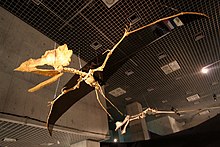
Summary
Ornithocheiroidea (or ornithocheiroids) is a group of pterosaurs within the extinct suborder Pterodactyloidea. They were typically large pterosaurs that lived from the Early to Late Cretaceous periods (Valanginian to Maastrichtian stages), with fossil remains found all over the world except Antarctica.
| Ornithocheiroids | |
|---|---|

| |
| Restored skeleton of Thalassodromeus sethi, with Anhanguera behind | |

| |
| Skeletal cast of Tropeognathus mesembrinus in the National Museum of Brazil | |
| Scientific classification | |
| Domain: | Eukaryota |
| Kingdom: | Animalia |
| Phylum: | Chordata |
| Order: | †Pterosauria |
| Suborder: | †Pterodactyloidea |
| Infraorder: | †Eupterodactyloidea |
| Clade: | †Ornithocheiroidea Seeley, 1870 |
| Subgroups | |
Ornithocheiroids were the most advanced group of pterosaurs, as the group includes the clade Azhdarchoidea, of which its members lived until the Maastrichtian stage of the Late Cretaceous, around 66 million years ago. Notable pterosaurs from this group include the pteranodontians Pteranodon and Nyctosaurus, the ornithocheirid Ornithocheirus, the anhanguerid Tropeognathus, as well as the azhdarchids Hatzegopteryx and Quetzalcoatlus.
Classification edit
The name Ornithocheiroidea was originally defined as an apomorphy-based taxon by Christopher Bennett in 1994. It was given a relationship-based definition in 2003 by Alexander Kellner, who defined it as the least inclusive clade containing Anhanguera blittersdorffi, Pteranodon longiceps, Dsungaripterus weii, and Quetzalcoatlus northropi.[2] Later that year, David Unwin suggested a more restrictive definition, in which the clade only contains Pteranodon longiceps, Istiodactylus latidens, and their descentants.[3] Brian Andres (2008, 2010, 2014) in his analyses, defined Ornithocheiroidea using the definition of Kellner (2003) to avoid confusion with similarly-defined groups, like Pteranodontoidea.[4][5]
Below is a cladogram showing the results of a phylogenetic analysis presented by Longrich and colleagues in 2018. They found Ornithocheiroidea to consist of the clades Pteranodontoidea and Azhdarchoidea, as well as the genus Piksi.[6]
| Eupterodactyloidea | |
In 2019, a phylogenetic analysis conducted by Kellner and colleagues had recovered Ornithocheiroidea as the sister taxon of the Archaeopterodactyloidea, and consisting of the clades Tapejaroidea and Pteranodontoidea.[7] Several recent studies have followed this or a similar concept.[8][9][10] The cladogram of the analysis by Kellner and colleagues is presented below:
References edit
- ^ Unwin, David M.; Heinrich, Wolf-Dieter (1999). "On a pterosaur jaw from the Upper Jurassic of Tendaguru (Tanzania)". Mitteilungen aus dem Museum für Naturkunde in Berlin, Geowissenschaftliche Reihe. 2: 121–134.
- ^ Kellner, A. W. A., (2003): Pterosaur phylogeny and comments on the evolutionary history of the group. pp. 105-137. — in Buffetaut, E. & Mazin, J.-M., (eds.): Evolution and Palaeobiology of Pterosaurs. Geological Society of London, Special Publications 217, London, 1-347
- ^ Unwin, D. M., (2003): On the phylogeny and evolutionary history of pterosaurs. pp. 139-190. — in Buffetaut, E. & Mazin, J.-M., (eds.): Evolution and Palaeobiology of Pterosaurs. Geological Society of London, Special Publications 217, London, 1-347 doi:10.1144/GSL.SP.2003.217.01.11
- ^ Andres, Brian Blake (2014). Systematics of the Pterosauria. Yale University. p. 366. A preview that shows the cladogram without clade names
- ^ Andres, B.; Clark, J.; Xu, X. (2014). "The Earliest Pterodactyloid and the Origin of the Group". Current Biology. 24 (9): 1011–6. doi:10.1016/j.cub.2014.03.030. PMID 24768054.
- ^ Longrich, N.R., Martill, D.M., and Andres, B. (2018). Late Maastrichtian pterosaurs from North Africa and mass extinction of Pterosauria at the Cretaceous-Paleogene boundary. PLoS Biology, 16(3): e2001663. doi:10.1371/journal.pbio.2001663
- ^ Kellner, Alexander W. A.; Weinschütz, Luiz C.; Holgado, Borja; Bantim, Renan A. M.; Sayão, Juliana M. (August 19, 2019). "A new toothless pterosaur (Pterodactyloidea) from Southern Brazil with insights into the paleoecology of a Cretaceous desert". Anais da Academia Brasileira de Ciências. 91 (suppl 2): e20190768. doi:10.1590/0001-3765201920190768. ISSN 0001-3765. PMID 31432888.
- ^ Kellner, Alexander W. A.; Caldwell, Michael W.; Holgado, Borja; Vecchia, Fabio M. Dalla; Nohra, Roy; Sayão, Juliana M.; Currie, Philip J. (2019). "First complete pterosaur from the Afro-Arabian continent: insight into pterodactyloid diversity". Scientific Reports. 9 (1): 17875. Bibcode:2019NatSR...917875K. doi:10.1038/s41598-019-54042-z. PMC 6884559. PMID 31784545.
- ^ Borja Holgado, Rodrigo V. Pêgas, José Ignacio Canudo, Josep Fortuny, Taissa Rodrigues, Julio Company & Alexander W.A. Kellner, 2019, "On a new crested pterodactyloid from the Early Cretaceous of the Iberian Peninsula and the radiation of the clade Anhangueria", Scientific Reports 9: 4940 doi:10.1038/s41598-019-41280-4
- ^ Jiang, Shun-Xing; Zhang, Xin-Jun; Cheng, Xin; Wang, Xiao-Lin (2020). "A new pteranodontoid pterosaur forelimb from the upper Yixian Formation, with a revision of Yixianopterus jingangshanensis" (PDF). Vertebrata PalAsiatica. doi:10.19615/j.cnki.1000-3118.201124.


